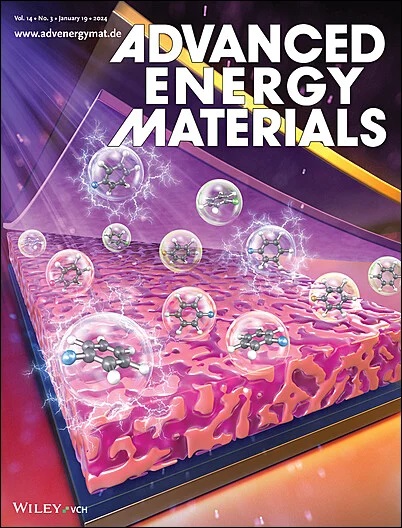使用熔盐电解质在高温下启用金属氟化物阴极
IF 24.4
1区 材料科学
Q1 CHEMISTRY, PHYSICAL
引用次数: 0
摘要
转换型金属氟化物(MFs)阴极是高能锂离子电池的有前途的候选者。然而,由于有机溶剂电解质在阴极/电解质界面的分解和循环过程中活性物质的溶解,特别是在高温(60℃以上)下,它们的循环性能受到限制。为了应对这些挑战,开发了一种由三种低熔点碱全氟磺酰亚胺盐组成的热稳定有机无溶剂电解质(OSFE),有助于最大限度地减少不必要的溶剂分解。此外,采用化学气相沉积技术对具有代表性的MF NiF2进行保形碳涂层,有效地防止了活性物质的溶解。OSFE和碳涂层的协同作用使得以前不可循环的NiF2阴极在80°C下循环160次后显示出450 mAh g - 1的高可逆放电容量。此外,通过在OSFE中加入10 wt.%的Li10GeP2S12 (LGPS), NiF2的循环次数扩展到300次,在60°C下保持350 mAh g−1的令人印象深刻的放电容量。这些进步突出了使用OSFE在高温下成功运行MFs的潜力,为其实际应用和未来的商业化铺平了道路。本文章由计算机程序翻译,如有差异,请以英文原文为准。

Enabling Metal Fluorides Cathodes at Elevated Temperatures Using a Molten Salt Electrolyte
Conversion-type metal fluorides (MFs) cathodes are promising candidates for high-energy lithium–ion batteries. However, their cycling performance is limited due to the decomposition of organic solvent electrolytes at the cathode/electrolyte interface and the dissolution of active materials during cycling, especially at elevated temperatures (above 60 °C). To address these challenges, a thermally stable, organic solvent-free electrolyte (OSFE) composed of three low melting alkali perfluorinated sulfonimide salts is developed, which helps to minimize the undesirable solvent decomposition. Additionally, chemical vapor deposition technology is employed to apply a conformal carbon coating to a representative MF, NiF2, effectively preventing the dissolution of active materials. The synergistic effect of OSFE and carbon coating enables a previously uncyclable NiF2 cathode, which exhibits a high reversible discharge capacity of 450 mAh g−1 after 160 cycles at 80 °C. Moreover, by incorporating 10 wt.% Li10GeP2S12 (LGPS) into the OSFE, the cycle number of NiF2 is extended to 300 cycles, maintaining an impressive discharge capacity of 350 mAh g−1 at 60 °C. These advancements highlight the potential for successful operation of MFs at elevated temperatures using OSFE, paving the way for their practical applications and future commercialization.
求助全文
通过发布文献求助,成功后即可免费获取论文全文。
去求助
来源期刊

Advanced Energy Materials
CHEMISTRY, PHYSICAL-ENERGY & FUELS
CiteScore
41.90
自引率
4.00%
发文量
889
审稿时长
1.4 months
期刊介绍:
Established in 2011, Advanced Energy Materials is an international, interdisciplinary, English-language journal that focuses on materials used in energy harvesting, conversion, and storage. It is regarded as a top-quality journal alongside Advanced Materials, Advanced Functional Materials, and Small.
With a 2022 Impact Factor of 27.8, Advanced Energy Materials is considered a prime source for the best energy-related research. The journal covers a wide range of topics in energy-related research, including organic and inorganic photovoltaics, batteries and supercapacitors, fuel cells, hydrogen generation and storage, thermoelectrics, water splitting and photocatalysis, solar fuels and thermosolar power, magnetocalorics, and piezoelectronics.
The readership of Advanced Energy Materials includes materials scientists, chemists, physicists, and engineers in both academia and industry. The journal is indexed in various databases and collections, such as Advanced Technologies & Aerospace Database, FIZ Karlsruhe, INSPEC (IET), Science Citation Index Expanded, Technology Collection, and Web of Science, among others.
 求助内容:
求助内容: 应助结果提醒方式:
应助结果提醒方式:


